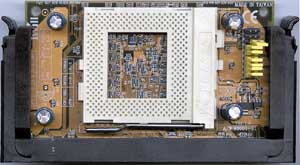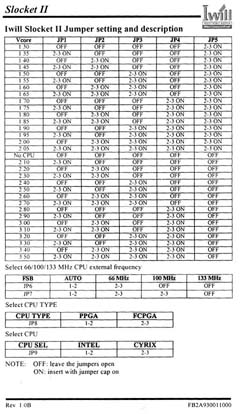Iwill Slocket II Socket-370 to Slot-1 Adapter
by Elliott Lee Hazen on January 23, 2000 11:14 PM EST- Posted in
- CPUs
For overclocking fans, Intel's new Pentium III's offer a glut of new options as explained in the FC-PGA overclocking guide part 1 and part 2. However, almost all motherboards that currently support FSB speeds of 133MHz are Slot 1 -- thus the resurgence of the Socket-370 to Slot-1 adapters.
AnandTech recently got its hands on Iwill's Slocket II adapter -- one of two from a major manufacturer with FC-PGA support that is currently available. However, there are a few snags to be wary of when trying to convert a FC-PGA Pentium III to Slot-1. Because the pin definitions have changed between the Socket-370 PPGA Celeron and the FC-PGA Pentium III, older Socket-370 to Slot-1 adapters do not support the Pentium III. Therefore, it is important to make sure that the adapter is FC-PGA compliant.
When trying to use a Slocket II in an older motherboard, do not forget to make sure the motherboard supports the lower voltage of the FC-PGA Pentium III and that the BIOS has been updated recently to allow proper detection of the chip. Fortunately, the adapter does not decrease the stability of the system at all but two slockets cannot be used in a Dual CPU system.
Other than the introduction to the adapter, AnandTech wanted to explain the jumper settings because many Slocket II's have been shipped without instructions. The Iwill adapter is inundated with jumpers allowing optimal customization for overclocking situations described in the spec sheet to the left. Jumpers 1 through 5 are used to set the core voltage and can be set from 1.30 - 2.10V in 0.05V increments and from 2.10V up to 3.50V in 0.10V increments. Jumpers 6 and 7 adjust the state of the pins that manipulate whether the motherboard detects the CPU as a 66, 100, or 133MHz FSB processor. Even though the many recent boards allow these states to be changed manually, this option is useful for boards that force the use of the detected FSB. Jumper 8 is the most important jumper for FC-PGA overclocking simply because it must be set to correspond with the FC-PGA chip. There are two settings -- PPGA for Celerons and FC-PGA for the Pentium III's but the default is PPGA. The final jumper, J9, must be changed from the default settiong for Intel processors when using Cyrix's rival processor, the Joshua. However, because it is not yet available, we have not been able to test it in our labs.
Once the Pentium III gains full popularity in the market, motherboard manufacturers will almost always opt for Socket-370 interface over Slot-1 because it is cheaper to manufacture Socket-370 chips. Until then, adapters such as the Slocket II will be in high demand for overclocking enthusiasts.












0 Comments
View All Comments